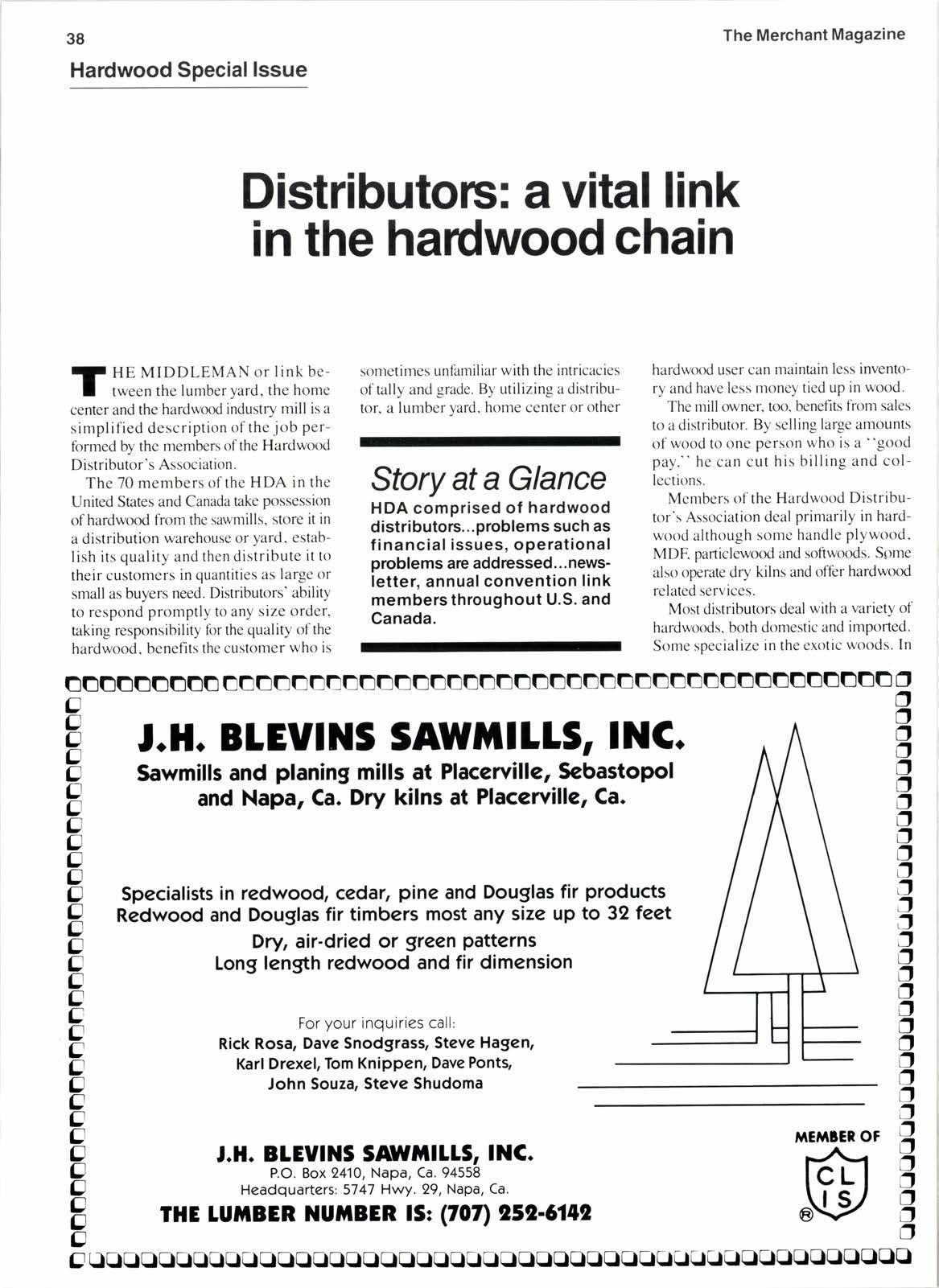
5 minute read
Distributos: a vital link in the hadwood chain
HE MIDDLEMAN or link between the lumber vard. the home center and the hardwood industry mill is a simplified description of the job performed by the members of the Hardwood Distributor's Association.
The 70 members of the HDA in the United States and Canada take possession of hardwood from the sawmills, store it in a distribution warehouse or yard, establish its quality and then distribute it to their customers in quantities as large or small as buyers need. Distributors' ability to respond promptly to any size order, taking responsibility for the quality of the hardwood. benefits the customer who is sometimes unfamiliar with the intricacies of tally and grade. By utilizing a distributor, a lumber yard, home center or other
Story at a Glance
HDA comprised of hardwood distributors...problems such as f inancial issues, operational problems arc addressed...newsletter, annual convention link members throughout U.S. and Canada.
hardwood user can maintain less inventory and have less money tied up in wood.
The mill owner, too, benefis from sales to a distributor. By selling large amounts of wood to one person who is a "good pay," he can cut his billing and collections.
Members of the Hardwood Distributor's Association deal primarily in hardwood although some handle plywood, MDF. particlewood and softwoods. Some also operate dry kilns and offer hardwood related services.
Most distributors deal with a variety of hardwoods, both domestic and imported. Some specialize in the exotic woods. In addition to stocking a number of species, they inventory a variety of thicknesses to meet the specialized needs of customers such as cabinet makers, custom furniture companies and manufacturers of musical lnstruments.
Orn Gudmundson, president of Northland Corp., LaGrange, Ky., association president, estimates that members of the association sell in excess of 400 million board feet of hardwood each year. Another source familiar with hardwood distribution estimates that distribution yards sell well over a billion feet of hardwood lumber a year, accounting for about 20% of all hardwood lumber produced, about $500 million.
The association is based on the common interest of hardwood and represents its members in problems unique to the product. The group is diversified in interests with members representing small companies doing less than $l million a year in business as well as the chains with numerous warehouses.
Membership in the group is open to any distributor. Applications for joining are available from the secretary/treasurer who also acts as membership chairman, Arthur Poletz, Schaller Hardwoods, Poplar Bluff. Mo. There is no association office or executive director. Members handle the operation of the organization.
Dealing with problems is a major function. Research into the use of net tally as opposed to green mill tally is an ongoing project. The organization also deals with legislation as necessary although it no longer retains a lobbyist. Financial issues are a function as are operational problems. The resources of the association are used each year to have a CPA compile a privileged financial report of the industry.
The association produces a newsletter sent out to members. An annual convention is held each year in conjunction with the National Hardwood Lumber Association. The Hardwood Distributor's Association meeting is held the weekend prior to the NHLA meeting in the same location to facilitate cost and travel for those attending both meetings. Most members belong to both associations as well as one or several wholesale hardwood groups.

Northwest Bu i ldi ng Showcase
New products and sales ideas will be featured at the annual Building Products Showcase of the Western Building Material Association. Nov. 8ll at the Red Lion Inn, Bellevue, Wa.
Practical and immediately usable information, inspirational speakers and enjoyable social events are the goals ofthose planning the convention which will be held in conjunction with the building products show. "Building Our Name Through Service" has been chosen as the theme of the annual meeting.
Exhibit spaces are still available. Reservations may be made through the association office in Olympia, Wa.
Both exhibitors and dealers from throughout the Northwest are expected to be on hand for the show which is considered the best in the area.
Housewares Exposition Refund
The Board of Directors of the National Housewares Manufacturers Association voted a 7 % refund of exhibit fees to all exhibitors in the April, 1986, NHMA International Housewares Exposition. This action was taken at the recent annual meeting and continues the long estabI ished practice of the association.
To date, more than $7.8 million has been refunded. The housewares industry remains the only industry worldwide which operates its own trade show on a not-for-orofit basis.
Hardwood Industry Changes
Demand for more specialization is one ofthe biggest changes in the hardwood industry in the past 50 years, according to a veteran hardwood man.
Robert S. Cockroft, owner ofSouthern Star in McKenzie. Tn.. has been in the hardwood business since the end of World War II. His firm, originated by Clyde, Roscoe and Robert H. Smith in 1915, is the oldest continuously operating industrial firm in its area.
Customers now want "a separation of grades, packaging, kiln drying and surfacing," Cockroft says. "Today users seem to want more of one grade of lumber. And the demand is sreater than in the
lmpulse Buying ls Increasing
While d-i-y purchases in the home center and purchases in the supermarket may seem to be worlds apart, they are in reality similar. Shoppers often enter both stores with specific lists of items to be bought and leave with carts full of unplanned purchases.
Findings of the Point of Purchase
Advertising Instirute on supermarket consumer buying habits apply equally well to both supermarket and home center past fbr separation of lengths. Many customers ask for only one or two lengths in a shipment, rather than five or six lengths, as in earlier years."
Other changes noted by Cockroft include the increasing importance of computers in hardwood lumber manufacturing as well as for sales and inventories. Utilization of the entire hardwood tree is another new development.

"The whole tree is now used by the mill or merchandised. Chips go to cardboard and paper manufacturers. Bark goes into mulch for nurseries and architectural landscaping. Sawdust and other refuse is used as fuel by some mills. Most mills use sawdust or sell it." Cockroft explains.
L-P To Buy Kirby In South
Louisiana-Pacific Corp. and Santa Fe Southern Pacific Corp. have signed a nonbinding letter of intent for L-P to buy SFSP's wholly-owned subsidiary, Kirby Forest Industries, Inc., for $315 million. The agreement is subject to the approval of both companies' boards of directors and appropriate governmental agencies. The two parties must also reach accord on a definitive purchase agreement.
Kirby Forest Industries owns about 650,000 acres of timberland in East Texas and Louisiana, plus three complexes that manufacture plywood, lumber and particleboard. Not included in the contemplated sale are 520,000 acres of timberland owned by SFSP in Northern California.
merchants. The study found 8l% of all purchases are a result of an in-store decision. The study also showed that only 19.3% of purchases were specifically planned, indicating that less than a fifth of all shoppers stick to their lists. Impulse purchases are on the rise with specifically planned purchases down nearly 50% from the l%7 study. Unplanned purchases accounted for 60.4% of all purchases in the latest study. Substitute purchases jumped from3% in 197 to 5% in the recent pilot study.
Top 10 Building Permit Cities
Los Angeles, Ca., led the country in building permit valuations last year, rising 13.7 % to $3.54 billion. New York City, N.Y., ranked second with $2.37 billion, followed by Dallas, Tx., $2.O7 billion; San Diego, Ca., $1.9 billion; Phoenix, Az., $1.27 billion. Rounding out the list: Houston, Tx.; Austin, Tx.; San Francisco, Ca.;Chicago, Il., and Nashville, Tn.

3










